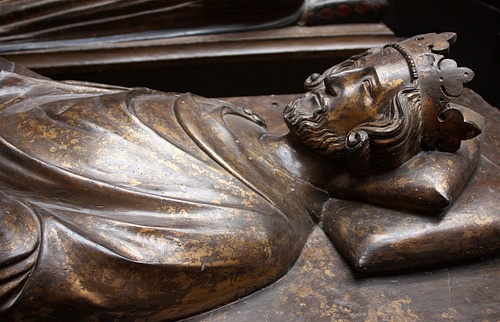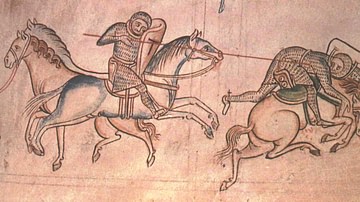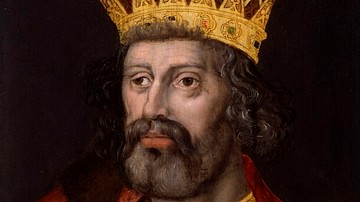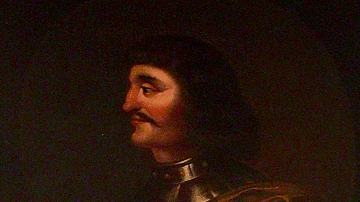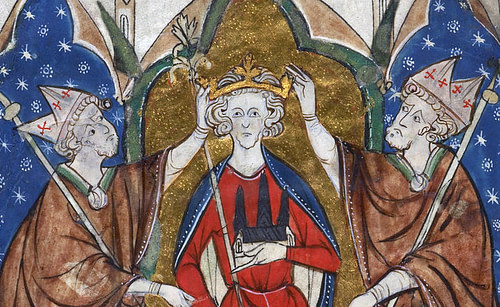
Henry III of England ruled from 1216 to 1272 CE. The son of the unpopular King John of England (r. 1199-1216 CE), Henry was immediately faced with the ongoing Barons' War which had been fuelled by discontent over John's rule and his failure to honour the Magna Carta charter of liberties. Henry and his regent Sir William Marshal defeated the rebel barons in battle at Lincoln in 1217 CE, but his reign was beset thereafter with problems. Traditionally viewed as a weak and often ineffectual king, Henry, like his father before him, wasted money on military campaigns without any results, and these necessitated such high taxes that the barons rebelled for a second time. The rebel leader Simon de Montfort (l. c. 1208-1265 CE) captured Henry and made himself the most powerful man in the kingdom in 1264 CE. Fortunately for Henry, his son Edward raised an army and defeated de Montfort at Evesham in 1265 CE. Henry was restored but spent much of his later years away from politics and improving the country's architectural monuments such as Westminster Abbey and Lincoln Cathedral. Following Henry's death from natural causes in 1272 CE, Prince Edward, who had in some respects been his father's regent, became Edward I of England (r. 1272-1307 CE).
Succession
Henry was born on 1 October 1207 CE at Winchester Palace in Hampshire, the son of King John of England and Queen Isabella of Angouleme (c. 1188-1246 CE). The young prince would be thrust into the limelight of state before any preparation was possible. King John died of fever on 18 October 1216 CE when Henry was still only nine years old. John had died in the middle of the First Barons' War (1215-1217 CE) which was caused by the king not honouring the promises set out in the Magna Carta of June 1215 CE. This charter of liberties established that even the sovereign was subject to the rule of law and the barons should be consulted on matters affecting them. So upset were some of these aristocrats with their present king, they supported Prince Louis (the future Louis VIII of France, r. 1223-1226 CE) as a replacement. Louis had invaded southern England and captured many of its prime castles, including the Tower of London. In May 1216 CE, Louis had even proclaimed himself king based on the fact he was married to Blanche of Castile, granddaughter of Henry II of England (r. 1154-1189 CE).
Amongst this turmoil, Henry III succeeded his father and was crowned king on 28 October 1216 CE in Gloucester Cathedral. The rush-job ceremony was further spoiled by the absence of the Archbishop of Canterbury (away in Rome) and the lack of any royal regalia, King John having lost the Crown Jewels in quicksand when he was fleeing from the rebel barons. In the absence of a crown with any pedigree, a gold torque necklace of Henry's mother Queen Isabella was used instead.
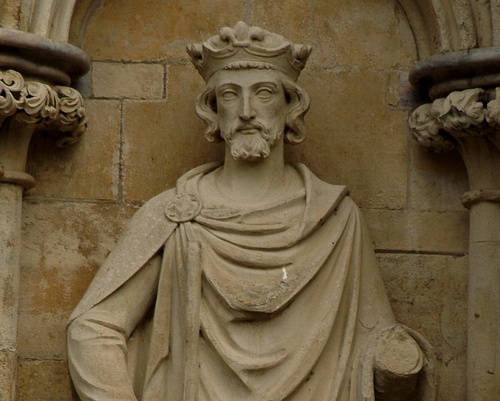
Henry's first task, then, was to bring an end to the civil war that blighted his kingdom. Henry was only nine years old, but he did have help from such figures as Peter des Roches and Hubert de Burgh (d. 1243 CE), and one truly great ally: Sir William Marshal, Earl of Pembroke (c. 1146-1219 CE), often considered the greatest medieval knight of all. Marshal had served three kings already and he was now made the Protector of the Kingdom - in effect, regent of England for the young Henry. This unlikely pairing of a child-king and a 70-year old knight would prove to be a winning one.
Barons' War & William Marshal
Crucially, the king held on to Windsor Castle and Dover Castle so that Henry could face the remaining rebel barons and Prince Louis at Lincoln on 20 May 1217 CE. Marshal led the English army in person, and just before the battle he gave a rousing speech to his frontline troops, declaring that the enemy had so positioned their forces that he would win the day because he could attack with all his army at a single section of the opposition; and so it turned out. A French reinforcement fleet of 80 ships was sunk in the Channel on 24 August by an English fleet of 40 ships commanded by Hubert de Burgh. The English fleet feigned an attack but then manoeuvred to come at the French downwind. Crossbow fire and pots of quicklime were launched at the enemy and in the confusion, only 15 French ships escaped. After this double defeat, Louis renounced his claim to the English throne in a treaty signed in September 1217 CE. The victory permitted Henry to enjoy a proper, full-pomp-and-ceremony coronation at Westminster Abbey on 17 May 1220 CE. William Marshal, meanwhile, having now served four kings in his illustrious life, died on 14 May 1219 CE. The new regent was Hubert de Burgh, who had served as Justiciar as well as defeating the French navy, but he would be needed for only a few more years.
Reign & Criticisms
Henry took on direct rule in January 1227 CE, aged 20. The historian Dan Jones gives the following description of the king:
The man that emerged from the long road out of childhood was a peculiar specimen. Henry was about 5' 6” in height. He was said to have a drooping eyelid, which would have given his face a crooked solemnity to match his somewhat ponderous character. He was noticeably pious, even in an age where the rising fashion among kings was for asceticism and ostentatious religiosity. (236)
What the king lacked in good looks he certainly made up for in longevity. However, the king quickly gained a reputation for being indecisive and easily swayed. Even worse, the barons never took to him, perceiving him as just as arrogant of his rights and disrespectful of theirs as King John had been. Another criticism was that the king was rather too generous with land grants to foreigners. This was worsened after his marriage to Eleanor of Provence (1223-1291 CE) on 20 January 1236 CE, and an influx of French in-laws took key positions at court, even becoming close advisors to the king and fuelling his incendiary idea that the monarch had absolute authority and need not listen to his barons.
There were some good points to Henry, at least from posterity's view. The king was a great patron of the arts and sponsored many important building projects such as the new St. Albans Cathedral, Lincoln Cathedral, Wells Cathedral, and Salisbury Cathedral. There was a major upgrade of Westminster Palace, making the traditional royal residence altogether more comfortable with new windows, fireplaces, wall paintings, and plumbing. Westminster Abbey was renovated in the Gothic style, and a magnificent new shrine was built therein to the former king, Edward the Confessor (r. 1042-1066 CE). The Abbey was also given by the king a crystal phial thought to contain the blood of Jesus Christ. Yet another building to receive the king's attention was the Tower of London. Henry probably started the zoo there which would remain until 1835 CE. The first animals were usually diplomatic gifts such as leopards, an elephant, and even a polar bear. Finally, the king was very keen on education and, between 1249 and 1264 CE, he created or funded the first three colleges at Oxford University (Merton, Balliol, and University).
Architectural and educational achievements were hardly the way to win over his subjects, though, and, in any case, these were mostly done in his final decade of rule. Certainly, they did nothing to stay the negative reaction to the king's heavy taxation policies, a string of military defeats in Wales (1228, 1231, and 1232 CE) which led to Henry conferring on Llywelyn ap Gruffudd (c. 1223-1282 CE) the title of Prince of Wales, and a bungled attempt to collude with Pope Innocent IV (r. 1243-1254 CE) and make Henry's second son, Prince Edmund, the king of Sicily. Then there were ineffectual campaigns across the Channel in 1228, 1230 CE (led by the king in person), and 1242 CE, resulting in the ultimate loss of territories in France, signed away in the Treaty of Paris in 1259 CE which left nothing to the English crown except Gascony. Finally, the king's arrangement of the marriage of his sister Isabella to the Holy Roman Emperor Frederick II (r. 1220-1250 CE) - an act backed by the ruling council - necessitated a huge cash dowry that stretched the taxation system to its very limits. In short, Henry, on an annual income that was half that of his French counterpart Louis IX of France (r. 1226-1270 CE), was living beyond his means.
Simon de Montfort & Civil War
All of these disappointments exasperated the barons to such an extent that some supported the king's brother-in-law Simon de Montfort, Earl of Leicester and made him, in effect, co-ruler with Henry. The Provisions of Oxford (June 1258 CE) set out that taxes should go to the Treasury and not be available for the king's whims, and that a ruling council of 15 barons should advise the king. The council was also to control royal castles, supervise ministerial appointments (which Henry was notoriously lax at), and control local administration. Another body, which some historians credit de Montfort as calling a parlement, meaning a body for discussion of policy, was, when knights of the counties and burgesses of certain boroughs were invited to participate, the beginnings of the English Parliament. The parlement was also designed to ensure the council was performing its duty.
In 1261 CE Henry called on the Pope to restore his full control of the kingdom, and he repudiated the Provisions of Oxford in 1262 CE, a decision backed by Louis IX of France. Consequently, civil war broke out. On 14 May 1264 CE de Montfort captured Henry and his son Prince Edward at the Battle of Lewes. For the next year, Henry has ignominiously shifted about as part of de Montfort's travelling entourage. Although de Montfort claimed himself to be, in effect, king (he called himself 'Steward') and he forced Henry to sign laws and decrees in his favour, Edward managed to escape his captors in May 1265 CE. The prince then formed an army of loyal supporters of his father and those barons already disgruntled with the self-seeking de Montfort. On 4 August 1265 CE, at the Battle of Evesham in Worcestershire, Edward was victorious thanks to his having a larger army than his opponent, de Montfort was killed and his body terribly mutilated. Edward reinstated his father as king but took over some aspects of the daily running of the kingdom himself. It seemed Henry was destined to share his power at both ends of his reign.
Death & Successor
Henry died, probably of a stroke, on 16 November 1272 CE aged 65; he had reigned for an impressive 56 years, a record that would not be beaten until George III of England (r. 1760-1820 CE). He was buried in Westminster Abbey and succeeded by his son who had already been ruling in his name and who now became Edward I of England. Edward was crowned on 19 August 1274 CE at Westminster Abbey and he would reign until 1307 CE. The new king would subdue Wales, have a good go at conquering Scotland, embark on what is sometimes called the Ninth Crusade (1271-2 CE), and build many fine castles which still survive today, particularly in North Wales.

